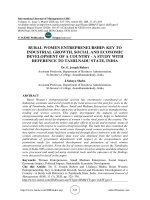Economic growth and economic development 387
Bạn đang xem bản rút gọn của tài liệu. Xem và tải ngay bản đầy đủ của tài liệu tại đây (147.43 KB, 1 trang )
CHAPTER 8
The Neoclassical Growth Model
We are now ready to start our analysis of the standard neoclassical growth model
(also known as the Ramsey or Cass-Koopmans model). This model differs from the
Solow model only in one crucial respect: it explicitly models the consumer side and
endogenizes savings. In other words, it allows consumer optimization. Beyond its
use as a basic growth model, this model has become a workhorse for many areas
of macroeconomics, including the analysis of fiscal policy, taxation, business cycles,
and even monetary policy.
Since both the basic equilibrium and optimal growth models in discrete time
were already presented as applications of dynamic programming in Chapter 6, this
chapter focuses on the continuous time neoclassical growth model (returning to
discrete time examples in exercises).
8.1. Preferences, Technology and Demographics
Consider an infinite-horizon economy in continuous time. We assume that the
economy admits a representative household with instantaneous utility function
(8.1)
u (c (t)) ,
and we make the following standard assumptions on this utility function:
Assumption 3. u (c) is strictly increasing, concave, twice continuously differentiable with derivatives u0 and u00 , and satisfies the following Inada type assumptions:
lim u0 (c) = ∞ and lim u0 (c) = 0.
c→0
c→∞
More explicitly, let us suppose that this representative household represents a
set of identical households (with measure normalized to 1). Each household has
an instantaneous utility function given by (8.1). Population within each household
373









